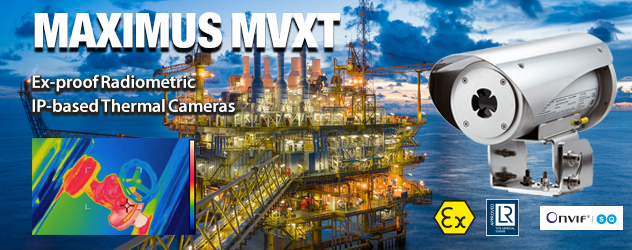Videotec announces that the MAXIMUS MVXT explosion-proof IP-based thermal cameras have been enhanced with new radiometric functions to provide an efficient and preventative surveillance system in hazardous areas.
The MVXT thermal cameras offer temperature detection based on the 4 central pixels of the image. With the advanced versions, the temperature of a specific object can be measured at any point in the image by means of defining a specific area. As well as this, the radiometric functions offer the option to set a temperature limit, beyond which an alarm will be raised.
These functions are necessary in the monitoring of industrial processes or critical equipment, where the ability to identify something quickly and accurately, thus preventing problems or failures and keeping intervention times to a minimum, is essential.
The MVXT thermal cameras can export all the data necessary for centralized management of video feeds, data, and alarms, and make it available to VMS via the ONVIF Profile S and Profile Q communication protocols. Also, configuring and controlling thermal image parameters is possible via the ONVIF Thermal Service Standard. MVXT allows exploiting fully the features and the advantages offered by the thermal camera. This includes the ability to raise an alarm and initiate immediate actions in order to prevent accidents or unwanted intrusions into monitored areas.
Moreover, the extended certification temperature range of -60°°C to 65°C, along with a sophisticated cold start system, allows it to operate in harsh environments as standard. The IP66/IP68 ratings guarantee the complete protection against harsh weather and the IP69 rating allows the device to be cleaned with high-pressure water jets. The MVXT has obtained Lloyds Register Marine Type Approval certification for the maritime and naval sector.
The MVXT thermal camera with radiometric functions is perfect for effective video surveillance and process control in harsh settings where the presence of gases or flammable dust can create a potentially explosive environment, a reality often found in the oil and gas industries or marine and industrial sectors.



